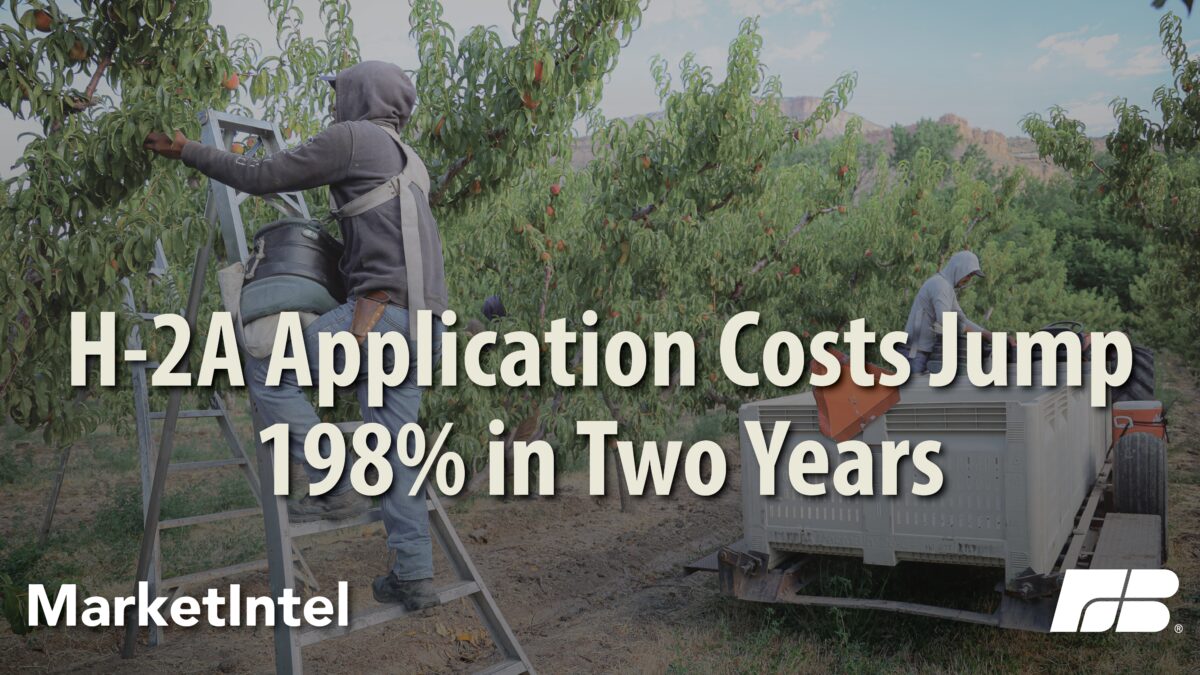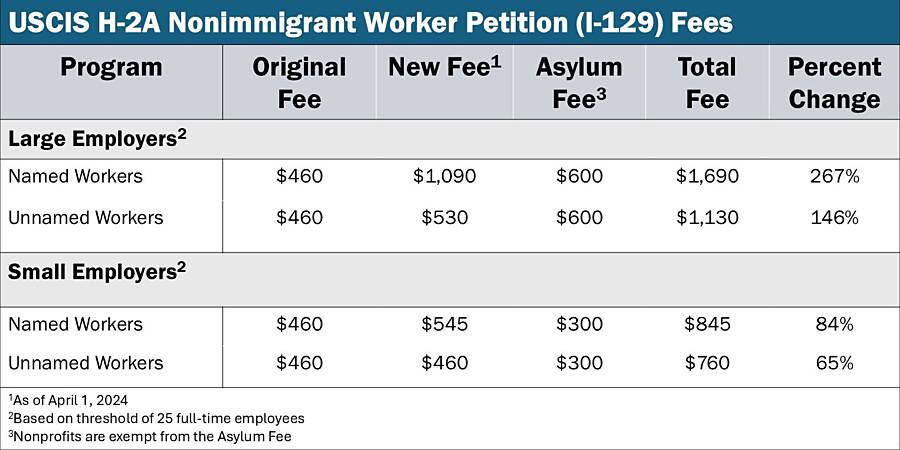Snail Mail and Government Bills: H-2A Application Costs

Samantha Ayoub
Economist
Applying for certifications and visas for H-2A temporary agricultural workers is the beginning of a long list of requirements for farmers who cannot find enough U.S. workers. Farmers who are unable to find domestic farmworkers may petition the U.S. government to grant foreign workers temporary work visas. This process requires interactions with three different federal agencies, all with independent application processes and, of course, corresponding fees.
Despite workers being required to apply for their visas themselves, H-2A employers bear the responsibility for paying or reimbursing all application fees associated with H-2A employment. In recent years, rapid increases to agency fees have hit farmer’s margins in nearly every step of the H-2A filing process. These fee increases are the latest in a long line of costly updates to H-2A employer requirements, most notably mandated wages that are increasing much faster than domestic wages or inflation. These costs rack up as farmers are waiting on much needed farmworkers during time sensitive planting and harvesting seasons when an extra day of administrative delays could mean the difference between a perfect or lost crop, and each additional dollar could threaten the farm’s financial future.
Pay To Order Of: Department of Labor
The first step of the federal H-2A petition process is having the Department of Labor (DOL) certify the need for foreign workers. Employers must electronically submit an Application for Temporary Employment Certification that prompts DOL to ensure proper steps have been taken to recruit domestic workers. It’s important to note that farmers’ requests for agricultural guest workers are only approved after they exhaust recruitment efforts to seek domestic workers for these positions. The fees associated with this application vary depending on how many workers an employer intends to bring in for the designated timeframe, each not exceeding 10 months. Each employment contract has a $100 application fee with an additional $10 per worker requested. The average H-2A contract requests 20 workers, so in the first step of the process, DOL alone is paid $300 for one H-2A contract. There is a maximum fee of $1,000 for any employer applying for foreign employment certifications. While the application can be submitted electronically, DOL invoices the application during processing, and all payments require a mailed check or money order.
DOL considers a “timely” processing period as under three months. Over 98% of applications in fiscal year 2024 received their determination in this timeframe. However, the DOL certification is only the first step in granting H-2A workers visas to work in the U.S., and three months can quickly add up to a long, drawn-out recruitment period.
Pay To Order Of: Department of Homeland Security
Once DOL certifies foreign workers are needed because the domestic workforce did not apply for the advertised jobs, employers can then begin the visa process. U.S. Citizenship and Immigration Services (USCIS) under the Department of Homeland Security (DHS) requires a Petition for a Nonimmigrant Worker (I-129 form). These forms are required for all work visas that do not have access to citizenship, including the H-2A program. Even in the modern digital age, USCIS only accepts paper I-129 forms that are mailed to the department. Any errors with the hard-copy application would be returned through the postal service and must be resubmitted.
In 2024, USCIS changed their payment structure to raise fees and fund an unrelated asylum program. Prior to the fee changes, all employers paid a flat $460 per work contract, regardless of the number of employees they wished to employee or if they were specifically listing the employee to be brought into their employment. After April 1, 2024, USCIS raised fees for any employee who is specifically requested on the form, which are typically those nonimmigrant employees who are seeking to transfer from one place of employment to another. A petition with named workers now costs $545 for employers with less than 25 employees or $1,090 for larger employers. Large employers also saw an increase to unnamed petitions – those without specifically listed employees – as they now pay a minimum of $530 per petition. The new fee schedule also limited I-129 forms to 25 employees per petition; so, any employer with more employees pays a higher certification fee per contract in addition to filing multiple petitions.
Additionally, each employer must pay $300 or $600 per petition, depending on how many workers they employ, to support processing of asylum applications. Despite an executive order suspending processing of refugee and asylum applications, USCIS is still collecting fees from nonimmigrant employers to fund the program.
In total, these fee changes raised USCIS processing costs by up to 267% per petition. Since some employers are also now required to submit multiple petitions, H-2A application fees to USCIS alone more than doubled for many employers.
Department of Homeland Security also plays an important role in allowing H-2A workers into the U.S. Once workers receive a visa and seek entrance to the United States, they must also have their visa examined and approved upon admission. U.S. Customs and Border Protection is in charge of checking entry paperwork at ports of entry to the U.S., whether travelers arrive by plane or car. Each of these approval border stamps currently costs $6. However, starting July 22, 2025, that fee jumped to $24 per person, a 300% increase. If the average H-2A contract has 20 workers seeking access and employment, that is $360 more per year just to admit workers, who have already been vetted and approved, to the U.S. The new fee schedule will also allow border stamp costs to increase each year with inflation, so farmers face a continuously climbing application fee.
Starting Oct. 1, 2025, DHS will also be responsible for implementing a new “visa integrity fee”. This fee will be a minimum of $250 for every nonimmigrant visa, including H-2A, issued. Farmers face uncertainty in how much this new fee will truly cost, as the Secretary of Homeland Security has authority to raise this fee to any level beyond $250, and may raise the fee yearly to accommodate inflation. However, since DHS does not issue visas, there is still logistical planning needed to coordinate payment of this new fee. Meaning there may be yet another hurdle for employers and employees added to the H-2A filing process. This fee may be reimbursed once workers return to their home country, within the confines of the visa requirement, but it is unclear how this will work for programs like H-2A where employers must reimburse employees in the first paycheck for all visa fees incurred. Especially since H-2A visas remain valid for three years, and employees may work for multiple farmers over that time period.
Pay To Order Of: Department of State
Once H-2A employees have been recruited in their home countries to fill a certified employment opportunity, they must apply for a visa allowing them entrance and work eligibility in the U.S. This is where the name “H-2A” comes from, as it is the visa class temporary agricultural workers receive. The Department of State conducts all visa applications and interviews for temporary and permanent immigration seekers alike.
Each employee must submit their own DS-160 visa application and pay $205, which must be reimbursed by the employer in their first work paycheck. This fee has also increased in the last two years. Prior to June 17, 2023, H-2A visa applications were $190. After applications and fees have been received, each employee must travel to a U.S. embassy or consulate to conduct an in-person interview, at the expense of the H-2A employer. Each visa lasts up to three years, and returning workers may be eligible for interview waivers, but any first-time, expired or visa applicants who have not been in the U.S.in the last year must apply, pay the $205 fee and conduct their in-person interview. Starting Sept. 2, 2025, the State Department will stop issuing interview waivers for H-2A workers, so all employees will have to attend an in-person interview before they are approved for entry to the United States.
In Mexico, where over 90% of H-2A workers are from, there are nine different locations that process H-2A visas. Most H-2A applications are directed to the consulate in Monterrey. While the State Department aims to have visa applications certified within three to-seven days of interviews, consolidation of visa processing to a few locations can lead to backups in processing capacity at the consulate in peak seasons. The discontinuation of interview waivers means demand for in-person interviews will further increase. Unfortunately, visa backlogs also leave U.S. farmers and ranchers waiting longer for employee certification in their own top growing season. H-2A employers must pay for all travel and housing in the consulate city while employees are waiting for interviews and approval. If delays occur, this means farmers’ costs also pile up while employees must live in a foreign city for extended periods. Since employees deal with the State Department directly, there can also be a lack of communication back to sponsoring employers, leaving the farmer confused with the status of their applications as they continue to pay living expenses.
Conclusion
H-2A filing is a convoluted process that requires juggling three different federal agency requirements, employee responsibilities and hard-copy mailing timelines. In total, application fees for just one H-2A worker will soon cost at least $1,350, nearly $600 more than just two years ago, and take months to process. For an average contract for 20 workers, application fees alone will cost at least $10,640, up over 127% in two years, and employers are advised to begin their application process 75 days before they plan to start employing workers. The application process often requires attorney assistance to navigate, meaning the total costs and time extend past the checks and paperwork mailed to the federal government. These applications and fees are just the beginning of a long list of requirements for U.S. farmers and ranchers once employees reach the United States, including rapidly inflating wages, housing and transportation – some of which begins during the filing process.
Fruit and vegetable growers that rely most on H-2A workers have narrow windows for growing and harvesting their perishable crops, and each additional step in the process introduces potential delays that could ruin that year’s crop. H-2A employers have long called for reforms to this application process to streamline applications, and DOL recently announced a new office to assist farmers in jumping through the hoops of nonimmigrant filings. American employers are well vested in the success of their employees throughout the application process and into their work season, and any step taken to ease the H-2A program’s complexity is a step toward providing opportunity to foreign farmworkers while supporting domestic farm production.
Starting Sept. 2, 2025, DOL will temporarily suspend collection of H-2A employment certification fees in order to transition to an online payment system. Any certifications during the suspension period will not be billed, and DOL will not retroactively seek payment. There is no announced end date for the suspension period.
Top Issues
VIEW ALL

